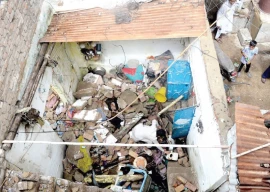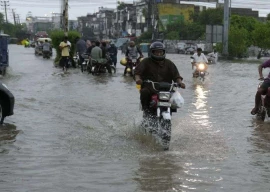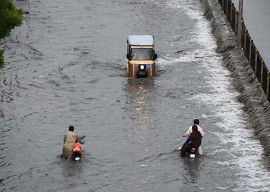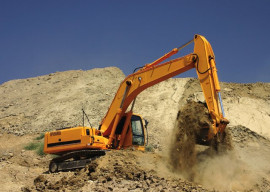
The year 2012 marked the first time the Arabian Sea waves stopped short of touching the stairs at Clifton beach, indicating that water is gradually receding and the shape of Karachi’s most popular hangout is changing forever.
But not all of it appears to be a natural phenomenon. According to the National Institute of Oceanography (NIO), the construction of a multi-billion dollar deepwater container terminal located one kilometre away has hastened the change.
“The sea is like water in a bathtub. Its flow goes down at one place and increases at the other,” said Syed Moazzam Ali, NIO’s chief scientific officer. “But we are amazed to note that the waves did not cover the usual distance even in the monsoon season.”
Along the beach, popularly known as Sea View, deposits of gray sand have covered the shoreline. At some places knee-deep sand has accumulated as the sea failed to take back the deposits.
Nadir Gardezi has done odd jobs along the beach for 15 years - from giving camel rides to managing four-wheel scooters. “The water has receded in the past three years. It’s moving further and further away from the [Sea View] road,” he said. To prove his point, he showed the canopy-shaped benches placed along the beach. “Only two feet of it is visible now. The rest of the marbled six feet is under the sand,” he said, digging frantically in a futile attempt to reach the platform.
At Amjad Ali’s makeshift hut in front of Bagh Ibn-e-Qasim, people leave their shoes when they go in the water. Not far from his spot, right before Oyster Rocks, there is a shipwreck under the sea. “Lately, it has become easy to dive and reach the wreckage,” he said, after explaining how he enjoyed collecting different items the sea offered, such as seashells, old boots, etc. “Doing that was impossible a couple of years ago.”

The wall of the 2.5-km-long breakwater, which is being constructed as part of the deep water terminal was also visible from this spot. The breakwater is a structure used to protect the harbour from the impact of waves and make it easy for the ships to anchor.
NIO’s Ali believed that the dredging for the breakwater could have caused the accumulation of sediments on the beach. “When the critical velocity of the sediments is more than the velocity of seawater, the sediments settle on the shore.” This means the sand on the beach is coming from somewhere else.
He suggested carrying out a detailed hydraulic study. “We would also need a sedimentological analysis and come up with ways to ensure that the shape of this place does not change for the worst.” There is a lack of data on the hydraulic regime of sea, making it difficult to measure how much the water has receded.
On the other hand, an environmental impact assessment report prepared by the Karachi Port Trust (KPT) mentioned that possible sediment starvation at Clifton beach should have caused the water level to rise instead. The 188-page report remains mostly silent about the exact consequences of the project on the beach. However, the authors of the report recommended, more than once, that a sedimentation modelling was needed to ascertain the fallout of wave and sediment movement.
Marine expert Rahid Yahya Usmani who was part of the team that prepared the report, said he could not immediately comment on the impact of the breakwater on the beach. “I would have to see it myself and do some research before commenting. But it looks very unlikely that something like that would happen.”
For its part, the KPT insisted that physical, hydraulic modelling and navigation studies were carried out before the project began. A study to look at any changes in wave patterns would be conducted after the breakwater, quay wall and dredging is completed, said an official.
Published in The Express Tribune, December 30th, 2012.



1724919810-0/Untitled-design-(12)1724919810-0-165x106.webp)






1722493456-0/rain-karachi67-(1)1722493456-0-270x192.webp)






1724910870-0/Untitled-design-(19)1724910870-0-270x192.webp)




COMMENTS
Comments are moderated and generally will be posted if they are on-topic and not abusive.
For more information, please see our Comments FAQ